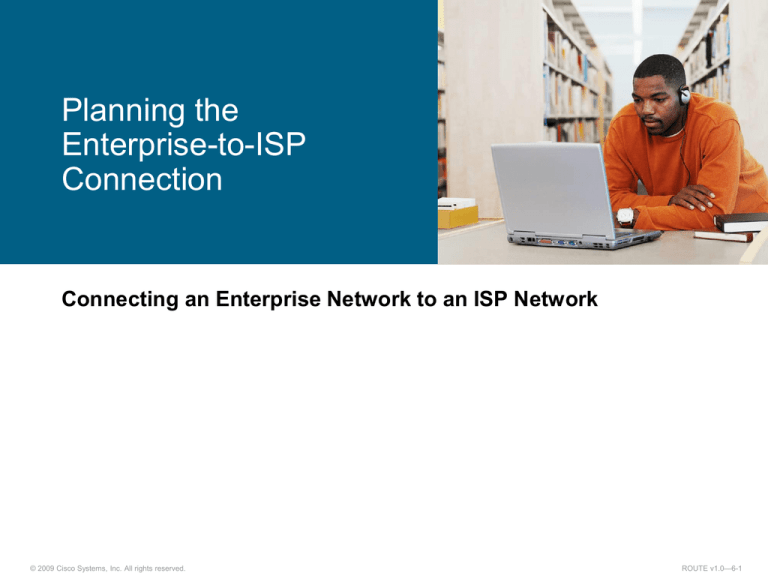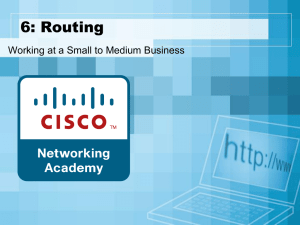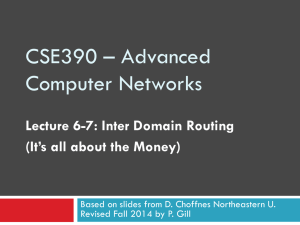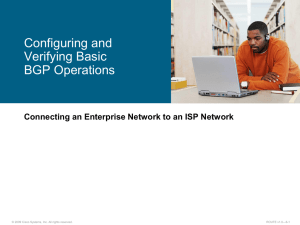
Planning the
Enterprise-to-ISP
Connection
Connecting an Enterprise Network to an ISP Network
© 2009 Cisco Systems, Inc. All rights reserved.
ROUTE v1.0—6-1
Session Origin Initiation
Enterprise session initiation requirement:
One-way: Connectivity from an enterprise network toward the Internet is
the only connectivity required.
Two-way: Connectivity from the Internet to an enterprise network is also
required.
Solutions:
One-way: private IP address space with address translation
Two-way: public IP address space (in combination with private)
and proper routing
© 2009 Cisco Systems, Inc. All rights reserved.
ROUTE v1.0—6-2
Enterprise Network-to-ISP Connectivity
Requirements
Public IP address space (subpool or whole /24 subnet)
Link type and bandwidth availability
Routing options
Connection redundancy
Independency in regard to an ISP:
– Public IP address space
– AS number
© 2009 Cisco Systems, Inc. All rights reserved.
ROUTE v1.0—6-3
Reachability
Circuit emulation
Static routes
MPLS VPNs
BGP
Static routes and BGP are typically selected for Internet
connectivity.
Previously covered
Not covered yet
© 2009 Cisco Systems, Inc. All rights reserved.
ROUTE v1.0—6-4
Using Circuit Emulation
Used to provide different Layer 2 connectivity to customers via the
common Layer 3 infrastructure of a service point
– Ethernet, Frame Relay, PPP, HDLC, ATM, Layer 2 connectivity
– No routing with the service point from the customer perspective
© 2009 Cisco Systems, Inc. All rights reserved.
ROUTE v1.0—6-5
Using Static Routes
The customer uses the default route toward the ISP.
The service provider uses static route(s) for customer public networks.
No automatic adjustment to any changes in the network.
© 2009 Cisco Systems, Inc. All rights reserved.
ROUTE v1.0—6-6
Using MPLS VPN
Used to connect multiple customer locations via a service provider’s common
Layer 3 infrastructure
– A special VPN can be used to provide Internet connectivity
– Routing used can be static or dynamic depending on the SP
– The customer routers are connected to the service provider PE routers
© 2009 Cisco Systems, Inc. All rights reserved.
ROUTE v1.0—6-7
Using BGP
The customer deploys BGP to announce its public networks
The ISP announces a default route, a subset of Internet routes,
or a complete Internet routing table
Typically used for inter-AS routing
CPE—Customer to Provider Edge router
© 2009 Cisco Systems, Inc. All rights reserved.
ROUTE v1.0—6-8
Enterprise Network-to-ISP Connection Options
Single-homed
Dual-homed
Multihomed
Dual-multihomed
© 2009 Cisco Systems, Inc. All rights reserved.
ROUTE v1.0—6-9
Single-homed ISP Connectivity
Link failure results in broken connectivity.
Option 1: Routing with static routes
A default route from an enterprise network
A static route(s) from an ISP for customer networks
Option 2: Routing with BGP
The customer announces its public network(s)
The ISP announces the default route to the customer
© 2009 Cisco Systems, Inc. All rights reserved.
ROUTE v1.0—6-10
Dual-homed ISP Connectivity
Characteristics:
Connected with two links to the same ISP
Can use a single router or two edge routers
Can use static routes or BGP
© 2009 Cisco Systems, Inc. All rights reserved.
ROUTE v1.0—6-11
Multihomed ISP Connectivity
Characteristics:
Connected to two or more different ISPs
Can use a single router or multiple edge routers
Dynamic routing with BGP
© 2009 Cisco Systems, Inc. All rights reserved.
ROUTE v1.0—6-12
Dual-multihomed ISP Connectivity
Characteristics:
Connected to two or more different ISPs with two links per ISP
Typically uses multiple edge routers (one per ISP)
Dynamic routing with BGP
© 2009 Cisco Systems, Inc. All rights reserved.
ROUTE v1.0—6-13
Summary
Connecting an enterprise network to an ISP requires, at a
minimum, a public IP address pool, a proper link to the ISP,
consideration of redundancy requirements, and the proper
routing protocol.
To exchange routing updates with an ISP, the customer can use
different options. Static routes and BGP are the options that are
most commonly used.
The way in which the customer connects to an ISP depends on
the redundancy requirements, where a single-homed connectivity
has no redundancy, and the dual-multihomed connectivity has the
most redundancy built in.
© 2009 Cisco Systems, Inc. All rights reserved.
ROUTE v1.0—6-14
© 2009 Cisco Systems, Inc. All rights reserved.
ROUTE v1.0—6-15











